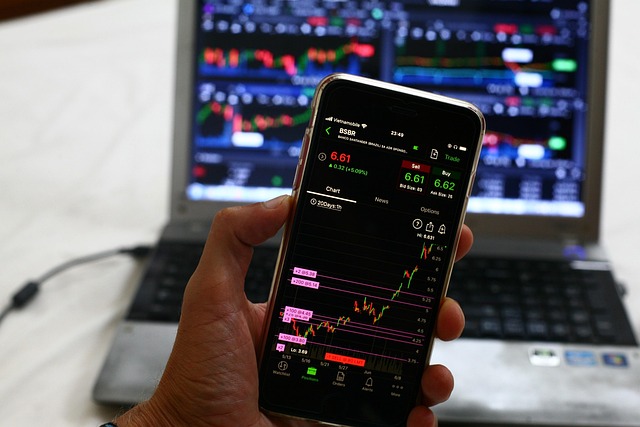Smart Choices: Best AI Apps for Share Trading and How to Use Them
Author: Jameson Richman Expert
Published On: 2025-11-01
Prepared by Jameson Richman and our team of experts with over a decade of experience in cryptocurrency and digital asset analysis. Learn more about us.
AI apps for share trading are changing how individual investors and professional traders analyze markets, discover opportunities, and execute trades. This article explains what these apps do, how they work, the benefits and limitations, how to choose and set up a reliable AI trading app, practical strategies, and risk-management best practices. You’ll also find links to hands-on resources (including demo-trading guides and platform reviews) and recommended exchanges for immediate testing and account setup.

What are AI apps for share trading?
AI apps for share trading are software tools that use artificial intelligence techniques — such as machine learning (ML), deep learning, natural language processing (NLP), and algorithmic signal generation — to help traders analyze securities, generate trade ideas, automate strategies, or execute trades. Unlike simple screeners or static indicators, these apps learn from historical market behavior, adapt to new data, and often combine multiple data streams (price, volume, news, sentiment, macro data) to create probabilistic trading signals.
For a quick overview of the technical foundation behind many AI trading solutions, see the Wikipedia entry on machine learning.
Related high-level concepts include algorithmic trading and quantitative finance; Investopedia’s guide on algorithmic trading is a useful primer.
How AI trading apps work (simplified)
- Data ingestion: Apps gather historical prices, order-book data, technical indicators, economic releases, news, social sentiment, and alternative data (satellite, credit-card data, etc.).
- Feature engineering: Raw inputs are transformed into features (momentum, volatility, correlations, sentiment scores) that models can use.
- Model training: ML models (random forests, gradient boosting, neural networks) or rule-based systems are trained and validated on historical data.
- Backtesting and walk-forward testing: Performance is evaluated out-of-sample and adjusted to avoid overfitting.
- Signal generation and execution: The app outputs signals (buy/sell/hold, position size) and may connect to brokers or exchanges for execution or generate alerts for manual trades.
- Continuous learning: Some systems retrain regularly to adapt to changing market regimes.
Key benefits of using AI apps for share trading
- Scalability: AI can screen thousands of stocks and cross-reference multiple datasets far faster than a human.
- Pattern discovery: Machine learning identifies complex, nonlinear relationships that conventional indicators may miss.
- Automation: Reduces manual execution friction and enables systematic, repeatable strategies.
- Sentiment and news integration: NLP can transform news and social-media chatter into actionable signals.
- Backtesting rigor: Many AI apps provide robust backtest engines and scenario analysis to test strategy robustness.

Common limitations and risks
AI trading apps are powerful but not foolproof. Traders must be aware of:
- Overfitting: A model that fits historical noise will fail in live trading.
- Data quality and survivorship bias: Poor or biased data produces unreliable signals.
- Regime shifts: Models trained in one market environment may underperform when conditions change.
- Execution risk: Slippage, latency, and liquidity constraints can erode theoretical returns.
- Black-box concerns: Some AI models lack interpretability, making risk assessment harder.
Features to look for in reliable AI trading apps
When evaluating AI apps for share trading, focus on these features:
- Transparent backtesting: Detailed equity curves, trade lists, slippage assumptions, and out-of-sample testing.
- Data sources and freshness: Access to tick-level or minute-level market data, newsfeeds, and sentiment providers.
- Model explainability: Ability to see which features drive signals and why a trade was generated.
- Paper trading/demo mode: Practice strategies without risking capital — essential before live deployment. For a comprehensive demo sharing guide, check this demo share trading app guide.
- Broker connectivity: Direct API integrations with reputable brokers to automate order execution securely.
- Customizability: Ability to tweak risk parameters, position sizing, and signal thresholds.
- Mobile access and alerts: Mobile apps and push notifications so you can monitor positions on the go. For mobile-focused guidance, see the TradingView mobile trading guide.
Popular types of AI trading apps and platforms
AI share-trading solutions typically fall into several categories:
- Signal providers: Apps that generate buy/sell signals or ranked lists (e.g., AI scans, momentum screens).
- Strategy builders and backtesting platforms: Tools that let you create, test, and optimize AI-powered strategies.
- Automated execution platforms: Full-stack systems that both generate signals and execute orders via broker APIs.
- Robo-advisors and portfolio managers: AI-led asset allocation solutions (typically longer-term and regulated). For investor-focused guidance on AI-managed solutions, see the SEC/Investor.gov overview on robo-advisers.

Real-world example workflows using AI apps for share trading
Example 1: Short-term momentum strategy
- Ingest minute-level price and volume for chosen universe (e.g., S&P 500 stocks).
- Engineer features: short-term momentum (5–20 min), intraday volatility, order-flow imbalance.
- Train a gradient-boosted tree with cross-validation to predict a 30-minute return bucket.
- Backtest assuming realistic slippage and fees; perform walk-forward testing to verify robustness.
- Deploy to demo/paper trading for 2–3 months and monitor Sharpe ratio, drawdown, and execution quality.
- After satisfactory demo performance, switch to live with strict position sizing and automated stop-loss rules.
Example 2: News-driven swing trades
- Use NLP to score company-specific news (earnings beats, guidance upgrades, regulatory news).
- Combine sentiment score with historical volatility and sector momentum to predict 3–7 day abnormal returns.
- Backtest across many event types; ensure no look-ahead bias in news timestamps.
- Trade via broker API with capped position sizes and predefined exit rules.
How to select the best AI app for your trading style
Selection depends on objectives, skill level, and capital. Use this checklist:
- Strategy horizon: Day trading, swing trading, or multi-year investing?
- Technical comfort: Do you want a GUI-based app, or will you build models with Python/R?
- Budget: Some platforms charge subscription fees or data costs.
- Broker compatibility: Ensure the app integrates with your broker or supports broker-independent trading (e.g., offers order export).
- Regulatory and security posture: Check if the app is SOC2 compliant, encrypts API keys, and follows best practices.
If you’re evaluating platforms for investing or active trading, you may find platform reviews helpful. For example, take a look at this in-depth Trading 212 platform guide to learn if that broker suits your needs.
Step-by-step setup: From demo to live trading
Follow these steps to go from concept to live trading safely:
- Define a clear hypothesis: What edge are you testing? Momentum, mean reversion, event-driven alpha?
- Collect and clean data: Use quality historical data and align timestamps precisely.
- Develop features and model: Start simple. Use robust cross-validation and prefer fewer, meaningful features.
- Backtest rigorously: Use rolling-window and walk-forward tests. Test across multiple market regimes.
- Paper trade thoroughly: Use a demo share trading app to simulate live conditions without risking capital — mastering demo practice is crucial; refer to this demo share trading app guide for best practices.
- Measure live performance: Compare live P&L to backtest results and track execution quality metrics.
- Scale gradually: Increase capital slowly while maintaining the same risk controls and monitoring for performance decay.

Practical risk-management rules for AI-driven trading
Integrate the following controls into every AI strategy:
- Max drawdown limit: Predefine a stop-trigger that halts trading if losses exceed X% over Y days.
- Position sizing: Use Kelly-based or fixed-fraction sizing informed by model volatility.
- Stop-loss and take-profit: Automate exits to avoid emotional decisions during fast markets.
- Model ensemble: Combine multiple models to reduce single-model failure risk.
- Portfolio diversification: Avoid concentrated positions in correlated securities.
Regulatory, privacy, and security considerations
AI trading apps operate in regulated environments. Key considerations:
- Broker regulation: Use regulated brokers that offer strong custody and settlement protections (e.g., FCA, SEC-regulated brokers). For country- or region-specific guidance on investing platforms, check investor-protection resources from your local regulator or the SEC investor educational pages.
- Data privacy: Ensure API keys and account details are stored securely and encrypted.
- Model auditability: Maintain logs and version control for models to detect drift and enable audits.
- Taxes and reporting: Understand local tax implications of frequent trading; keep accurate trade logs for reporting.
Demo and mobile trading: Practice before you commit
Paper trading is a must when testing AI strategies. Demo environments let you test real-time signal behavior, slippage, and latencies. For a practical guide on using demo trading apps to practice and refine strategies risk-free, see this demo share trading app guide.
Mobile access is increasingly important for monitoring and quick intervention. If you trade on the go, learn how TradingView’s mobile app handles alerts, charting, and execution by reviewing this TradingView mobile trading guide.

Common use cases and examples
- Retail traders: Use AI scanners to generate watchlists and automated alerts, then place trades manually or via broker APIs.
- Quant funds: Deploy high-frequency signals, statistical arbitrage, and factor-based portfolios at scale.
- Long-term investors: Use AI for portfolio optimization, tax-loss harvesting, and rebalancing signals.
- International investors: AI can screen cross-listed stocks and local exchanges. If you’re expanding into foreign markets — for instance, buying U.S. stocks from Mexico — this guide to buying U.S. stocks in Mexico helps explain the process and considerations.
Where to open accounts and test your AI strategies
To connect AI apps to live markets or paper-trade with real-time market conditions, you’ll need brokerage or exchange accounts. Below are convenient registration links for major exchanges and trading providers that many AI apps support via API integrations. These are commonly used for both crypto and equity-aligned strategies depending on the asset class and integration support:
Note: While some of the above platforms focus on cryptocurrencies, many traders use them for cross-asset strategies or for learning automated execution principles that apply to share trading. For a focused review of whether Trading 212 suits investors, read this Trading 212 platform guide which covers pros, cons, and investor suitability.
How to avoid common pitfalls and increase your odds of success
Follow these practical tips to minimize mistakes when using AI apps for share trading:
- Start with paper trading: Run your strategy through a demo environment for an extended period that includes different market conditions.
- Keep models simple initially: Complexity can hide overfitting. Prefer interpretable features and models at first.
- Monitor model drift: Track performance metrics and periodically retrain or recalibrate models.
- Limit leverage: AI can create false confidence; always control leverage and use risk caps.
- Log everything: Maintain clear version control and logs of data feeds, model versions, and live trades to troubleshoot performance issues.

Integrating AI apps with existing workflows
If you already use charts, broker platforms, or trade journals, integrate your AI app this way:
- Link AI signals into your existing charting platform (TradingView, MultiCharts) via alerts or webhooks.
- Export trade logs to your trade journal for post-trade analysis.
- Use API-driven order execution to reduce manual errors and improve timing.
- If you prefer to practice before trading live, consult this guide on mastering demo share trading apps for practical setup and strategy refinement.
Evaluating performance: metrics that matter
Don’t judge a model only by headline returns. Use these robust metrics:
- Risk-adjusted returns: Sharpe ratio, Sortino ratio.
- Maximum drawdown: Largest peak-to-trough decline; shows tail risk.
- Win rate and payout ratio: Combined with expectancy to gauge long-term viability.
- Trade turnover: Frequency of trades affects costs; higher turnover increases slippage and fees.
- Out-of-sample and forward performance: Real-world performance vs. backtest.
Advanced topics: Ensemble models, transfer learning, and alternative data
Experienced quants leverage advanced techniques to push model performance:
- Ensembles: Combining multiple models reduces variance and increases stability.
- Transfer learning: Use pre-trained models (e.g., on macro or sector data) and fine-tune them for specific equities.
- Alternative data: Incorporate satellite imagery, credit-card transaction aggregates, or web-scraped product reviews for unique edges.

Resources and further reading
- Machine learning (Wikipedia) — foundational concepts used in many AI trading apps.
- Algorithmic trading overview (Investopedia) — helpful background on automated strategies.
- Investor.gov: Robo-advisers — regulatory and investor-protection guidance.
- Mastering a demo share trading app — guide to practice, strategy, and risk-free learning
- Is Trading 212 a good platform for investing? — in-depth investor guide to a popular brokerage.
- How to buy US stocks in Mexico — ultimate 2024 investor’s guide — useful for international investors.
- Can you trade on TradingView mobile app? — mobile trading guide — explains mobile execution options and limitations.
FAQ: Quick answers about AI apps for share trading
Are AI trading apps better than human traders?
They are tools that can augment human decision-making. AI excels at processing large datasets and automating rules; humans still add judgment, oversight, and contextual understanding — especially during unexpected market events.
Can I make consistent profits using AI apps?
Yes, some traders and firms achieve consistent returns, but it requires rigorous testing, strong risk controls, high-quality data, and continuous model management. There are no guarantees.
How long should I paper trade before going live?
At minimum, paper trade through multiple market regimes (volatile, calm, trending) — typically 3–6 months for regular strategies. Longer for lower-frequency strategies to observe enough events.
Conclusion — practical next steps
AI apps for share trading offer powerful ways to analyze markets, automate strategies, and scale ideas—but they are not turnkey wealth machines. Start with a clear hypothesis, use robust data and conservative models, and practice extensively in demo mode. Use transparent backtesting, strong risk controls, and gradual live deployment. Explore platform reviews and demo guides to find the tools that match your goals: consider reading the demo share trading app guide for step-by-step practice techniques, the Trading 212 platform guide for broker evaluation, and the TradingView mobile guide if you plan to trade on the go. If you’re expanding internationally, consult the guide on buying U.S. stocks from Mexico to understand cross-border logistics and costs.
When you’re ready to test with real accounts, you can register with major platforms using these links: Binance registration, MEXC registration, Bitget registration, and Bybit registration. Always test strategies in a demo environment first and keep security, compliance, and risk controls in place.
Start small, test thoroughly, and let AI be a disciplined tool — not a shortcut — on your path to better share trading outcomes.